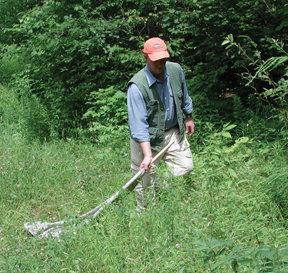Nervous Ticks
IPM Sets a Bleak Scene for Lyme Disease Carriers
 |
|
Tick check! A sweep through the brush in summer and fall reveals many fewer deer ticks just two weeks after plant-oil treatment. Photo courtesy of MMCRI. |
The threat of Lyme disease, a flu-like illness that can cause lasting neurological effects, has added a note of caution to outdoor activities in recent years. Those who live in the Northeast are on alert for ticks that carry the disease and for the distinctive “bull’s-eye” rash that signals infection. Deer ticks, the primary vector of Lyme disease, hide in brush and leaf litter waiting to feed on the blood of people, dogs, and livestock. Enter the Northeastern IPM Center, which funds research on ways to control ticks to protect human health while reducing the use of pesticides.
Plant Oils Knock Down Ticks
A food-grade blend of plant oils called IC2 shows promise for controlling ticks in southern Maine. Two projects at the Maine Medical Center Research Institute are investigating how the use of this environmentally friendly formula compares to conventional pesticides.
The primary benefit of IC2, which contains mostly rosemary oil, is that it is considered safer than conventional pesticides for people and animals. “There’s nothing to prevent cattle or horses from grazing in a pasture just sprayed with IC2,” explains project leader Peter Rand. In contrast, areas treated with many synthetic pesticides are off-limits to livestock for at least 12 hours following application.
Applied at the height of the 2008 tick season, IC2 was nearly as effective at controlling adult deer ticks as bifenthrin in a preliminary trial. The decrease in ticks lasted into the following spring.
A second project to test the effects of IC2 on different stages of the deer tick’s life cycle began in 2009. Researchers will also investigate the impact of the compound on nontarget insects, such as bees.
Park Staff Learn Tricks to Repel Ticks
In New Jersey, researchers have developed an IPM program to prevent bites by Lyme-infected ticks on public lands and roadways. The project reduces the need for pesticides by making landscapes less hospitable to ticks and training park staff to protect themselves from bites and serious health consequences.
Deer ticks thrive in dead leaves and brush, so reducing this type of habitat is key to shrinking their populations. At the project site, park staff removed brush from the edges of public trails where people hike and walk their dogs. Researchers also installed stations designed to kill ticks living on the skin of wild deer.
A high incidence of Lyme disease among staff who work on public lands has fueled demand for education on how to avoid tick bites and Lyme infection. “Every time we’ve run a training, we’ve filled the room,” says project director George Hamilton (Rutgers Univ.), whose half-day employee training sessions emphasize personal protection without the use of pesticides. New Jersey agencies, including the Department of Transportation, county governments, and state parks, are interested in using similar tactics across the state.
“The potential is huge in terms of people and employees not having to use repellants against ticks,” says Hamilton, who points out that the IPM strategies used in this project could be applied throughout the Northeast. The research team is measuring the impact of this integrated approach to managing ticks and expects to see a reduction in tick bites and pesticide use as the program is implemented.
Learn more about these projects by searching the Northeastern IPM Center’s project database. The Northeastern IPM Center encourages integrated pest management for reducing risks to human health and the environment.
— by DANYA GLABAU
The Northeastern IPM Center promotes integrated pest management for reducing risks to human health and the environment. If republishing our news, please acknowledge the source (“From Northeast IPM Insights”) along with a link to our website.
